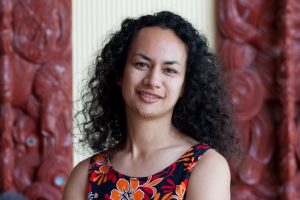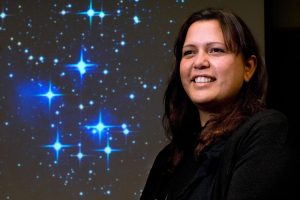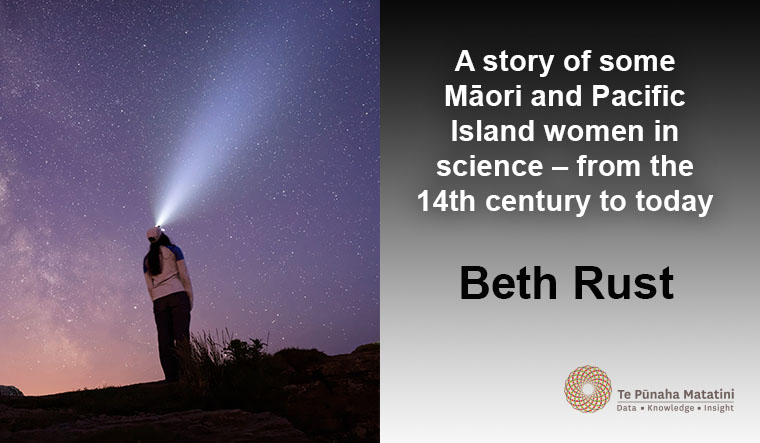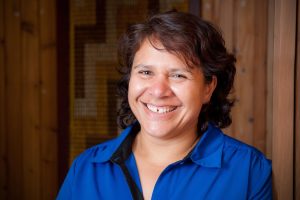Before I started working as a research assistant on the Hidden Networks project, the only woman from the history of New Zealand science I could name was Joan Wiffen, the “dinosaur lady” who discovered New Zealand’s first dinosaur fossils in Hawke’s Bay. She was a remarkable woman who contributed much to palaeontology here in New Zealand; she was also, incidentally, very white. I too am outwardly (that is, I pass as) very white. But as a mixed-race woman of Samoan descent, when I started this project I was very interested to learn about the contributions of non-Pākehā – chiefly, Māori and Pacific Island – women to science in Aotearoa. For the purposes of my research, I’ve taken “woman in science” to broadly mean a woman who has made a contribution to science in New Zealand, including both professional scientists with academic backgrounds and amateur scientists who have added to the pool of knowledge in their field, like Joan Wiffen.
The more I researched, the whiter the history of women in science in New Zealand came to look. Unsurprising really: according to Elizabeth McKinley, in 1998 just 1.5% of total employees at seven Crown Research Institutes in New Zealand identified as Māori women; there were none in management positions, and only two scientists. In ‘Finding Matilda’, Kate Hannah notes that “the historiography of science in New Zealand … tends to inadvertently reinforce [the] camouflage” of women. They are marginalized, but not absent: if you go looking, as I have, you’ll find a staggering number of women in New Zealand science from the 14th century to present-day. Yet from the beginnings of European presence in New Zealand, the overwhelming majority of these women were white. A feminist revisionist history of science aims not only to make science less male-centric (i.e. demonstrate, through promotion of women’s work both quantitatively and qualitatively, that science never has been just a man’s world) but also to make it less monochromatic (so to speak), which means celebrating the scientific achievements of brown women in New Zealand’s history, and showing that science never has been just a white world either.
In fact, the first women who made scientific contributions in Aotearoa were not Pākehā but Māori. I was delighted to learn of Whakaotirangi, who in the 1300s “was responsible for safeguarding the seed of the kūmara” as the Tainui Waka journeyed to Waikato. She was the wife of Hoturoa, the leader of the Tainui Waka migration from Hawaiki to Aotearoa, but also an important historical figure in her own right. In ‘Whakaotirangi: A Canoe Tradition’, Diane Gordon-Burns and Rāwiri Taonui explore how her importance has been diminished in post-European contact accounts of the Tainui migration. Tainui and Te Arawa traditions both speak of Whakaotirangi: she appears to be a noble and important ancestor in the history of both iwi. While she is most remembered for bringing kūmara to Waikato, she was also responsible for a number of other plants brought from Hawaiki. On arrival in Waikato, Whakaotirangi built gardens in which she experimented with growing and tending to a variety of plants, both for sustenance and medicinal purposes. She discovered how to make the kūmara, which had come from a much warmer climate, grow in the cooler land her people had settled. Her work was crucial for the establishment of the Tainui people: it provided them with a reliable food supply as they adjusted to life in a new land. She was also involved in commissioning, building and launching the Tainui canoe. Her profile on the Royal Society of New Zealand website, as part of their series 150 Women in 150 Words, credits her as “one of New Zealand’s first scientists”.
Around the middle of the 1400s, another important ancestor of the Waikato people appeared. Kahu (also known as Kahupeka, Kahupekapeka, Kahukeke, or Kahurere) was a Tainui woman who experimented with plants – such as harakeke, koromiko, kawakawa and rangiora – as medicinal remedies. She did so during her great journey: walking inland through the King Country while grieving the death of her husband (who in some accounts is Rakataura; in others Uenga). She gave names to different sites along her journey (such as Te Manga-Wāero-o-Te Aroaro-ō-Kahu – ‘the stream in which Kahu’s dogskin cloak was washed’) – these names tell the story of her journey and preserve the history of the land. At some point during her journey she was ill, which may have been why she sought out plants for their medicinal properties. Unfortunately there are many different versions of Kahupeka’s story, and in them there are few mentions of her medicinal experimentations with indigenous flora. In some versions Rakataura doesn’t die, and he and Kahu traverse the countryside naming places together, as explorers.
In Māori culture, practitioners or experts in any skill or art are known as tohunga. The Tohunga Suppression Act 1907 made tohunga status a punishable offence. The Act was repealed only in 1962, and so much of the knowledge surrounding this customary way of knowing has been suppressed – my search for tohunga wahine (female practitioners) who might count as women of science has not produced significant results. However, it is worth noting that the sources I accessed relied upon the written record. Other sources, such as Māori oral histories, may be much more fruitful.
The next Māori woman in science that I was able to find wasn’t born until the 19th century. Makereti Papakura (Margaret Pattison Thom; she also went by Maggie and was of Te Arawa and Tuhourangi iwi) was born to a Māori mother and an English father in the Bay of Plenty in 1873. She was raised by her mother’s aunt and uncle in Parekarangi, a rural area. She didn’t learn English until she was ten years old, speaking only Māori until her father took over her education. After her schooling, Papakura moved to Whakarewarewa, where she became an accomplished tourist guide. She gave herself the surname Papakura after a nearby geyser when a tourist she was guiding asked if she had a Māori surname. Clearly, the name stuck. In 1891 she married surveyor Francis Joseph Dennan; they had one child together before divorcing in 1900. In 1905 she wrote Guide to the hot lakes district. Papakura travelled to England in 1912, and married Richard Charles Staples-Browne. She had first met Staples-Brown when he was on a tour of New Zealand, and had reconnected with him while she was part of a Māori tour party in England. They divorced in 1924, but Papakura remained in England and in 1926 she enrolled at Oxford University, studying a BSc in anthropology. She died on April 16, 1930, only two weeks before her thesis, The old-time Māori – in which Papakura combined customary knowledge with scholarly conventions – was due to be examined. It was published posthumously, eight years later. Her thesis covers Māori social and familial structures, housing, weaponry and relationship with fire. She was meticulous in her writing, and wrote letters to her people in New Zealand during her drafting process, to ensure her account was as accurate as possible.
Bessie Te Wenerau Grace (1889-1944; Ngāti Tūwharetoa) was the first Māori woman university graduate, graduating from Canterbury University with a BA in 1926. She was the granddaughter of Ngāti Tūwharetoa chief Horonuku Te Heuheu. She then went on to receive an MA with first-class honours in modern languages from London University. In London she also became a nun, Sister Eudora. She worked as headmistress of St Michael’s School in Melbourne. In 1945, Dame Mira Szászy (1921-2001; Ngāti Kurī, Te Rarawa, and Te Aupōuri), a prominent Māori leader, became the first Māori woman to graduate with a degree from the University of Auckland. She went on to complete a postgraduate diploma in social sciences from the University of Hawaii and worked hard to improve the welfare of Māori women throughout her life. In 1949, Rina Winifred Moore (1923-1975; Ngati Kahungunu, Rangitane and Te Whanau-a-Apanui) graduated from the University of Otago with a Bachelor of Medicine and Bachelor of Surgery – and in so doing, became the first Māori woman doctor in New Zealand. In her career she worked to improve public perceptions of the mentally ill and was one of the first doctors in New Zealand to prescribe the contraceptive pill.
It has been harder for Māori and Pacific Islanders to enter scientific professions, as they are forced to combat social prejudices that expect them to fail – that tell them this is not where they belong. It has been harder for women to enter scientific professions because, again, they have to fight against the social biases that tell them ‘this is not your world’. Until the late 20th century, many women were expected to give up their careers when they married – motherhood and the domestic sphere became their full-time responsibilities. Some women chose to remain unmarried and childless in pursuit of scientific careers, while others stopped working when they married. Māori and Pacific women have to fight both gender and racial biases for their place in the world of science. This has been the case throughout the post-contact history of Aotearoa, and continues to be so.

Dr Ocean Mercier. Image courtesy of Dr Mercier and Image Services, Victoria University of Wellington.
Today, there are increasing numbers of Māori and Pacific Island women in science, with some of them working at the intersection of traditional knowledge and western science. Dr Ocean Mercier (Ngāti Porou) is a Senior Lecturer in Māori Science (the intersection of western science and mātauranga Māori) at Victoria University of Wellington. She has a PhD in Physics and was awarded the New Zealand Association of Scientists (NZAS) inaugural Lucy Cranwell Medal (previously the Science Communicators’ Medal) in 2017. Science researcher Hokimate Harwood (Ngāpuhi) combines western scientific and Māori customary knowledge in her research of the feathers in kahu huruhuru (feather cloaks). Her use of microscopy to identify the origins of feathers used in precious cloaks has been pioneering. She is a Bicultural Science Researcher at Te Papa. Her sister, Dr Matire Harwood (Ngāpuhi; PhD MBChB), is a Senior Lecturer at the University of Auckland Medical School and has done crucial research into indigenous healthcare throughout her career. Her efforts have been widely recognised, and in 2017 she was awarded a fellowship to the L’Oréal UNESCO For Women in Science programme.
Victoria University science educator Dr Hiria McRae (Te Arawa, Tūhoe, Ngāti Kahungunu) has created and developed a new educational model aimed at raising Māori students’ engagement in high schools. Through her research projects she has made important contributions to the field of Māori education.

Dr Pauline Harris. Image courtesy of Dr Harris and Image Services, Victoria University of Wellington.
Victoria University astrophysicist, science lecturer and research fellow Dr Pauline Harris (Rongomaiwahine and Ngāti Kahungunu), who has a PhD in astroparticle physics, is a key figure in the revitalisation and teaching of Māori astronomy. She is also involved in the search for extra-solar planets. Connected to Harris’s Māori astronomy programme is Pounamu Tipiwai Chambers, an undergraduate student at Victoria University who has employed Māori astronomical and navigational knowledge in undertaking waka voyages across the Pacific.
Another remarkable young woman, Alexia Hilbertidou (of Greek and Samoan descent), has founded GirlBoss New Zealand, an organisation aimed at the empowerment of young women in STEM studies after she felt alienated as the only girl in her year thirteen physics for engineering class. She was also part of NASA’s SOFIA project, making her the youngest person ever to be part of a NASA mission.
My blog post aims to contribute towards the unmasking of Māori and Pacific women’s contributions to science in both historical and contemporary landscapes. We are already seeing some important changes: many Māori women in science today combine customary and scientific knowledge to great success, a road paved by Makereti Papakura and her BSc thesis. However, Māori and Pacific women are still dramatically under-represented in fields of science, particularly at senior and management levels. It is therefore important that we keep up the momentum of positive change not only by looking forward but also by looking back: the successes of past figures provide an encouraging bevy of ‘shoulders to stand on’ for women in science today.
This post was written as part of my summer scholarship research on the Hidden Networks project, supervised by Rebecca Priestley and Kate Hannah.
Further reading
If you’re interested in learning more about the women I’ve mentioned, you might enjoy some of these sources:
- Colenso, William, ‘Contributions towards a better Knowledge of the Maori Race’, in Transactions and Proceedings of the Royal Society of New Zealand 1868-1961, Vol. 14, 1881, pp. 33-48. http://rsnz.natlib.govt.nz/volume/rsnz_14/rsnz_14_00_000690.html
- ‘Dr Ocean Mercier wins prestigious Science Communicator’s Medal.’ https://www.victoria.ac.nz/news/2017/11/dr-ocean-mercier-wins-prestigious-science-communicators-medal
- GirlBoss New Zealand. https://www.girlboss.nz/
- Hilbertidou, Alexia, ‘NASA SOFIA Experience’, U.S. Embasssy & Consulate in New Zealand. https://nz.usembassy.gov/alexia-hilbertidou-nasa-sofia-experience/
- ‘Hokimate Harwood – Identifying feathers’, Museum of New Zealand Te Papa Tongarewa. https://collections.tepapa.govt.nz/topic/3657
- Mack, Ben, ‘How Dr Matire Harwood is addressing inequities in healthcare for indigenous people’, Idealog, 3 November 2017. https://idealog.co.nz/etc/2017/11/how-dr-matire-harwood-addressing-inequities-healthcare-indigenous-people
- ‘Māori science education model developed’, Radio New Zealand, 28 August 2015. https://www.radionz.co.nz/news/te-manu-korihi/282635/maori-science-education-model-developed
- McKinley, Elizabeth. ‘Brown Bodies, White Coats: Postcolonialism, Māori women and science’, in Discourse: Studies in the Cultural Politics of Education 26 no. 4, 2005, pp. 481-496. http://www-tandfonline-com.helicon.vuw.ac.nz/doi/full/10.1080/01596300500319761?scroll=top&needAccess=true
- Morton, Jamie, ‘Royal Society tackling diversity issues’, New Zealand Herald, 26 October 2016. http://www.nzherald.co.nz/nz/news/article.cfm?c_id=1&objectid=11736157
- Morton, Jamie, ‘Q&A: NZ science’s own ‘Hidden Figures’, New Zealand Herald, 24 January 2017. http://www.nzherald.co.nz/nz/news/article.cfm?c_id=1&objectid=11787672
- Northcroft-Grant, June. ‘Papakura, Makereti’, Dictionary of New Zealand Biography, first published in 1996. https://teara.govt.nz/en/biographies/3p5/papakura-makereti
- ‘Researcher to teach traditional Māori astronomy’, Radio New Zealand, 17 June 2013. https://www.radionz.co.nz/news/te-manu-korihi/137868/researcher-to-teach-traditional-maori-astronomy
- Royal, Te Ahukaramū Charles, ‘Waikato tribes – Ancestors’, Te Ara – the Encyclopedia of New Zealand, http://www.TeAra.govt.nz/en/waikato-tribes/page-3
- Shaw, Aimee, ‘Meet Alexia Hilbertidou, the 18-year-old founder of GirlBoss and the youngest person to be involved with Nasa’s Sofia mission’, New Zealand Herald, 11 July 2017. http://www.nzherald.co.nz/business/news/article.cfm?c_id=3&objectid=11888757
- Tipiwai Chambers, Pounamu. ‘Te Ara Tauira’ in Salient, 1 May 2017. http://salient.org.nz/2017/05/te-ara-tauira-4/
Author
Beth Rust is a BA(Hons) history graduate from Victoria University of Wellington. For her Honours thesis she researched the writings of Christine de Pizan, a 15th-century humanist and early defender of womankind. This past three months she has been working as a research assistant on the project ‘Hidden Networks: hybrid approaches for the history of science’. Beth is just about to start a job in the public service, and she is very excited to take the skills she has learned from her summer research into her new role. She loved being a summer scholar.


